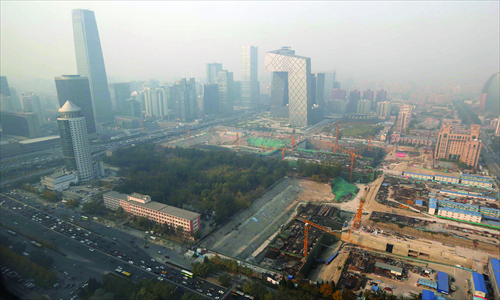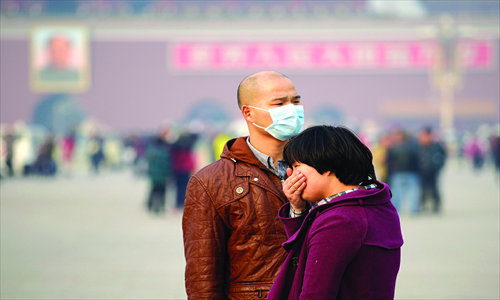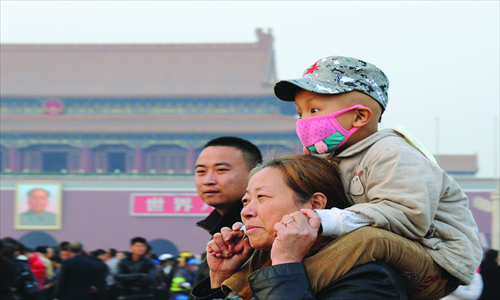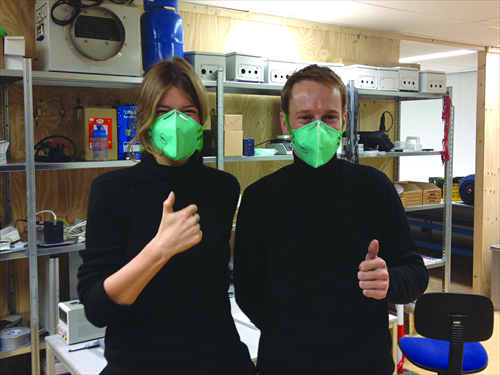Breath of fresh air

An effect picture of the design by Daan Roosegaarde, a Dutch artist who plans to create a vacuum-like device in Beijing that sucks away the smog and lets people see the sky again Photo: Courtesy of Daan Roosegaarde
One of the most popular, albeit bittersweet pastimes of Beijingers these days is posting pictures of the sky online. The difference between a bad day and a clear day can be striking, as if a veil has been lifted.While for most people air pollution is just another headache, for others, it is a challenge and opportunity, as the government pledges to solve this chronic problem with all the help it can get.
Foreign cities that have experience with severe air pollution, institutions that have advanced clean technology and individuals with bold ideas have all joined to help.

A smoggy day in Beijing's Central Business District Photo: CFP
Outside helpLast week, experts from the Royal Academy of Engineering in the UK came to Beijing for a seminar on air pollution.
On November 5, it was announced that Tsinghua University, Cambridge University and the Massachusetts Institute of Technology will launch a joint research center for transportation and work on ways to deal with car exhaust fumes to help curb air pollution in China.
In May, environmental ministers from China, Japan and South Korea agreed during a meeting in Japan to work together to tackle air pollution.
In April, China and Finland reached an agreement to cooperate in environmental protection work. The two countries will work together in areas such as introducing existing technologies and innovations, scientific research, as well as regulations and policies.
One result of the agreement is a two-year project called Beautiful Beijing which aims to improve living conditions - especially the air quality - in Beijing, through Finnish clean technology.
The project starts with an 18-month study to test new business models, technologies and services and define concrete action plans for pilot and demo projects, according to Eero Siitonen, director of Cleantech Finland for China, a project under FINPRO, the Finland Trade Center at the embassy of Finland in Beijing.
The project will bring in Finnish clean technology companies to work together with their counterparts in Beijing in areas such as renewable diesel fuel, converting waste into energy and air quality forecast technology systems.
"What we do is finding out what Beijing needs, and bring our companies and expertise here, and push things forward at a practical level," said Siitonen.
So far, 16 Finnish companies have agreed to participate and have proposed 11 projects to the Beijing Environmental Protection Bureau, said Siitonen, adding that he hopes some of the projects could start by the end of this year.

A man wears a face mask as another visitor covers her mouth at Tiananmen Square in Beijing on November 5. Photo: CFP
Several of the proposed spearhead projects focus on improving indoor living conditions, such as indoor air quality and energy efficiency in buildings. While solving air pollution might take a long time, it's possible to improve the situation indoors, where people spend most of their time, said Siitonen.
One of the challenges is figuring out the decision-making process, Siitonen said. Although the Beijing environmental protection bureau is championing the Beautiful Beijing project, it doesn't have the authority to approve the proposed joint programs. Cross-departmental cooperation would be needed.
The government has become increasingly aware of the problems caused by air pollution in the past two years. The authorities' attitude has shifted from denying to admitting the problem.
After accusing the US embassy in Beijing of "making trouble" with its reading of PM2.5 density, which measures the amount of small particles in the air that can penetrate people's lungs and pose health risks, the municipal government started to add PM2.5 to its air quality index last year.

Visitors at Tiananmen Square in Beijing on November 8 Photo: CFP
Innovative solutions
In September, the central and Beijing governments released a five-year action plan to tackle air pollution which included strict measures to limit the number of cars on the roads and to reduce dependency on coal.
But it might take years, even decades for such measures to have an effect. And as cities in North China turn on the heating for the winter, more smoggy days can be expected, and Beijing is certainly going to need all the help it can get. But the air can't be cleaned overnight. Or can it?
Daan Roosegaarde, a Dutch artist and innovator, has come up with the idea of creating a vacuum-like device that sucks away the smog and lets people see the sky again.
The idea is to charge the small particles in the air so that they can be attracted and captured like a magnet, Roosegaarde explains. The device creates a column of clean air while the rest of the area remains covered with smog.
He said he has already tested the idea in a 25-square-meter room in his studio in the Netherlands and hopes to test it in a 50 by 50 meter public park in Beijing.
Roosegaarde presented the idea to the vice mayor of Beijing during the Beijing Design Week, which concluded in early October. He said the officials showed interest in his idea and made a "verbal agreement" to try it out in a public park in Beijing. They will meet again but details have yet to be decided upon, Roosegaarde told the Global Times, adding that he hopes the project is up and running by mid-2014.

Roosegaarde (right) experiments with his assistant in his laboratory in the Netherlands. Photo: Courtesy of Daan Roosegaarde
The idea occurred to him when he was staying in a hotel in Beijing about five months ago. On a good day, he could see the iconic China Central Television tower, and on a bad day, he couldn't. Roosegaarde, who has created projects like "Smart Highway," which uses energy-efficient designs such as glow-in-the-dark markings and battery-charging lanes, which is being piloted in some cities, immediately thought of it as a "design problem."
Roosegaarde then teamed up with Bob Ursem, scientific director at Delft University of Technology in the Netherlands, who came up with the Positive Ionization method, and ESN Europe, a Netherlands-based company that provides innovative air cleaning technologies.
The technology behind the project is a combination of ionization and electrostatics, according to Lia van de Vorle, CEO of ESN Europe, which is the co-inventor, manufacturer and owner of the technology.
To put it simply, it's high school physics: a glass rod rubbed with silk cloth would be able to attract small pieces of paper or small objects.
"In basis, the system only contains just two basic elements, the electrode and the counter electrode. The electrode creates positive ions, who transfer their positive charge to the dust particles, and which will be forced to and collected on the counter electrode," explained Van de Vorle via e-mail.
She said they used smoke particles to simulate the situation in Beijing. "The smog will contain also other particles, but we are able to capture all particles smaller than PM10," she explained.
While some might see the vacuum cleaner idea as nothing more than a fun experiment, the team is taking it very seriously.
At this point, they are still working on the technology and design to make the device applicable on a much larger scale and remain safe enough for people who use pacemakers, said Roosegaarde. He also plans to turn the collected particles into wearable items, such as jewelry.
"It is technology and poetry together," said Roosegaarde. People will look up and see nature again, and the striking contrast will remind them of how bad the situation is and work to change things, he said.
No quick fix
Roosegaarde believes that technology and innovation is the way to go to solve the problem, but some are skeptical of quick fixes. The problem requires controls at the sources, said Thomas Cahill, an emeritus professor of physics at the University of California and expert on aerosols.
He said California, which has been fighting heavy air pollution since the late 1950s, had had zero success with schemes to remove particles from the air by technical means, except for removing the most dangerous fine particles onto vegetation.
Cahill has long focused on the movement of aerosols across national borders. In 2001, he headed a study called ACE Asia that tracks air pollution from Asian countries to the US. During the 2008 Olympics he analyzed the air quality changes in Beijing and came to the conclusion that most of the measures taken to improve air quality didn't seem to be working. The improved air quality was mostly attributed to good weather conditions, namely, wind.
Cahill is hoping that his team at the DELTA Group, which stands for the Detection and Evaluation of the Long-Range Transport of Aerosols, can measure the air in Beijing this winter to "evaluate whether the air is dangerous or just dirty."
Lia van de Vorle said the biggest challenge is that the air that has been purified will be polluted again with the "fresh" pollution which is transported by the wind. But the team is confident that the plan will work.
Roosegaarde believes his product is a real solution for smog locally, although it obviously can't make the whole city smog-free.
"But it's a powerful statement. It gives people an example of what the future could look like," he said.